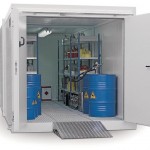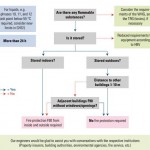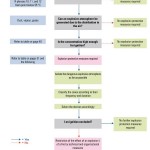For the extension of its paint storage facility, a medium-sized company was looking for a flexible and mobile solution that would allow paint and varnish to be stored in a safe and environmentally friendly way. The firm decided to install a flammable storage cabinet with a CE conformity declaration that meets the Atex 94/9/EC directive in every respect.
Peter Meyrahn
In the old days, the varnish manufacturer used to store varnish, thinner and curing agent on shelves in a separate masonry room close to the production area. The idea was to replace these stationary premises with a mobile and flexible container so- lution. Proximity to production was an important criterion. The company opted for the approved, BMC-X-600 fire protection module container. On this basis, engineers at Denios developed an appropriate storage concept in compliance with statutory requirements that takes account of environmental protection aspects and is also explosion-proof. The fire protection module container integrates the following equipment:
- Technical ventilation with 5 air changes per hour (Atex certified)
- Explosion-proof lighting with 2 x 36 W
- Door retaining device with national technical approval from the German DIBt (Deutsches Institut für Bautechnik) regarding safe opening of the door for loading and unloading
- Equipotential bonding (earthing)
- Collecting sump
All electrical devices (lighting, air conditioning, ventilation, pumps, fire detectors, etc.) can optionally be supplied as explosion-proof versions. This was necessary here because handling hazardous substances, e. g. varnish, paint and thinner, that are liable to cause an explosion represents a potential source of danger. The operating company has to prepare an expert risk assessment, the zone classification and an explosion protection document according to BetrSichV (German Occupational Safety Regulations). These documents serve as a starting point for assessing the safety risk. The technical ventilation system includes an explosion-proof fan, which is designed as a primary explosion-proof device in conformity with TRbF 20 to prevent flammable gas/air mixtures within the container, so that at least 0.4 air changes per hour are pos-sible. This ensures that flammable air/gas mixtures are safely discharged. However, it is also possible to increase the rate to five air changes without any problems. Five air changes are necessary if the store is actively used (e. g. for dispensing, filling or open containers). The built-in motor is explosion-proof as standard, with the EEx T4 type of protection for Zone 1 (degree of protection: IP 55), and designed for continuous operation. It is important to adapt the accessories to the ignition temperature of the material to be stored. The maximum surface temperature of the devices must be lower than the ignition temperature of the stored substances. After the order had been placed, the storage cabinet was manufactured at the Denios factory in Bad Oeynhausen.
Flexibly accommodated in the interior space
When the new storage cabinet was developed, several aspects had to be considered. About 3000 l of varnish and curing agent needed to be stored safely, centrally and close to the production plant. Another problem was that the company was located in a water protection area. It was therefore necessary to ensure that 100 % of the stored hazardous material would be collected. In Denios, the customer found a partner to support this objective who was familiar with all pertinent laws and regulations from more than twenty years of experience, for example with WHG (Water Resources Act) Section 19 at national level, as well as with VAwS (Regulation on the handling of substances constituting a hazard to water) at the level of the German Laender. The flexible fire protection container in the vicinity of the goods-in department had to be designed for mobile internal installation.
Fire protection class F90 was consequently essential because some of the products to be stored are marked R 10 (flammable), R 11 (highly flammable) or R 12 (extremely flammable). The Ex zones are defined as follows according to TRbF 20 – 8.4.3.2:
- Zone 0 = a place in which an explosive atmosphere is present continuously or for long periods or frequently. This is almost always the case inside devices (e. g. pumps) or above the surfaces of highly flammable liquids.
- Zone 1 = a place in which an explosive atmosphere is likely to occur in normal operation occasionally; this situation often occurs in conjunction with active storage and natural ventilation in the collection sump.
- Zone 2 = a place in which an explosive atmosphere is not likely to occur in normal operation but, if it does occur, will persist for a short period only, e. g. within a radius of 2 m x 0.2 m height in the vicinity of the storage systems and natural ventilation.
In this specific instance, the operating company assigned the hazardous material storage container to Zone 2 because the material is only stored passively; the area outside the container is not assigned to any zone. The container needed to be a walk-in type because mainly small trading units were stored. Varnish, thinner, and curing agents are classified as hazardous to water. To comply with WHG, a sump therefore had to be planned to collect leakage and spilled liquids.
The BMC-X 600 fire protection module container has a 1700 l collecting sump installed as standard. To meet the requirement for 100 % sump capacity, 3000 l had to be collected, which meant designing a new sump. Since Denios has its own design department and production facility, it was able to develop this customised solution very fast.
If thinner, varnish and curing agents are stored, TRbF 20 (technical regulations for flammable liquids) applies. As flammable liquids needed to be stored and a sufficient safety clearance of more than 10 m was not available, fire protection class F 90 was required both inside and outside. Denios solved this problem by using a fire protection module container with a 100 mm thick fire protection panel and internal and external frames. The internal frame protects the entire system in case of a fire on the outside while the external frame protects the system from internal fire.
Insurance coverage included
Adequate insurance coverage is an impor-tant prerequisite for a flammable storage cabinet. If the container is not tested and approved, the insurance company will not, or will only partially, pay up in case of fire. The Denios fire protection triangle provides security here. The approval by the DIBt in Berlin in accordance with WHG has been supplemented with the application of fire protection material to obtain a fully certified system with the stipulated fire protection class F 90 on both the inside and outside.
In the event of a fire, the container is completely sealed. Special materials swell up and seal the self-closing door hermetically. At the same time, the ventilation openings melt and are closed. The safety area formed in this way protects against fire from the inside to the outside as well as from the outside to the inside. The flammable liquids are stored passively, i. e. they are enclosed in their original packaging without refill-ing. A technical ventilation system thus has to ensure 0.4 air changes permanently according to TRbF 20. The built-in ventilation system meets these requirements and moreover has an explosion-proof design. After the container had been manufactured and accepted by the customer, it was delivered on a low-bed trailer. The hazardous substances could now be stored safely and all the requirements of the Atex 94/9/EC directive were met. Compliance with statutory requirements was guaranteed by a CE declaration of conformity.
Practical experience and a wide range of approved systems are indispensable when it comes to developing components for hazardous substances. To implement a safe overall concept, it is necessary to consider a wide range of specifications, regulations and directives. With the fire protection module container for indoor use, the customer acquired a solution tailored to its individual needs that is simultaneously space-saving and cost efficient. The fire protected container complies with current legislation and is consistent with the company´s in-plant environmental protection strategy. The requirements for explosion protection are met in every respect.
Online-Info www.cpp-net.com/2310449
Share:











